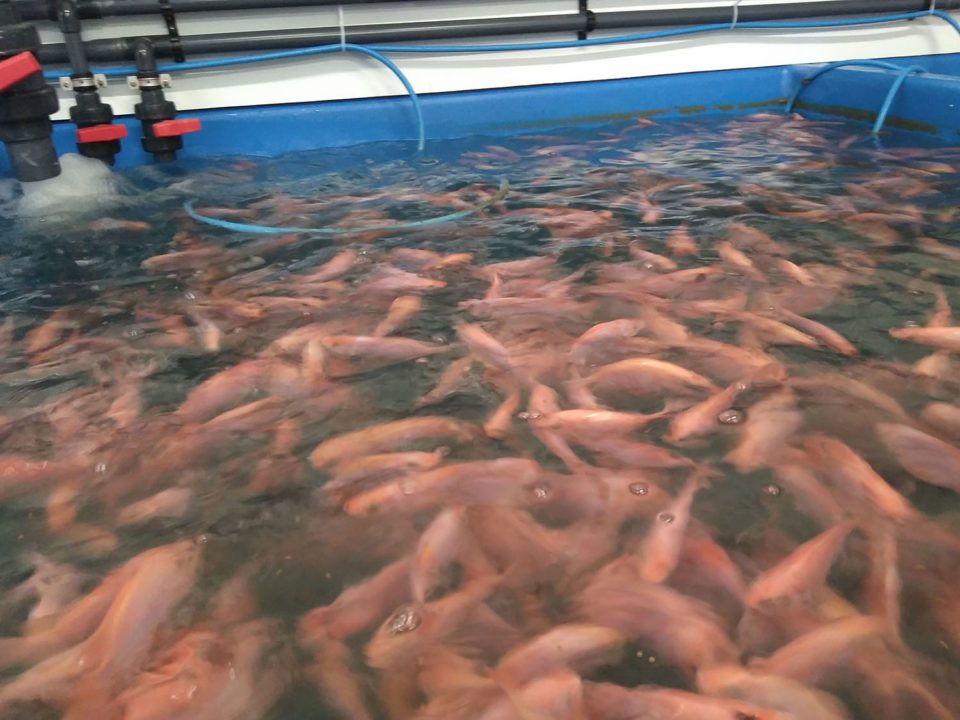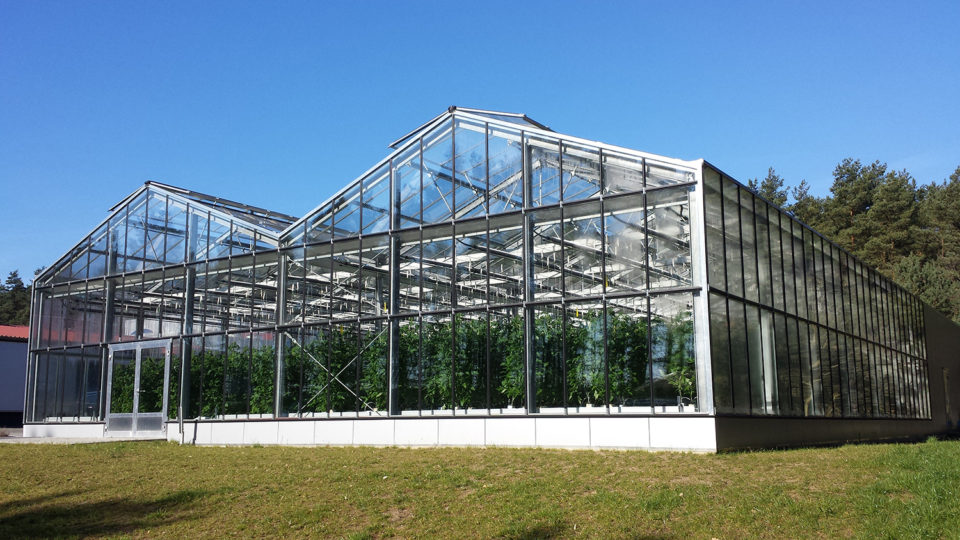INAPRO demonstrating its ‘double RAS’ technology in Germany, Spain, Belgium and China

As we hurtle towards the year 2050, when global demand for food will have increased by an estimated 60 percent – there will surely be an intensified focus on water resources.
Aquaponics – the combination of aquaculture and hydroponics (growing plants without soil) – is a system that purports to reduce the amount of water typically used in recirculation aquaculture systems (RAS). And in doing so, the use of pesticides, antibiotics, fertilizers sewage outputs are greatly reduced.
A Berlin-based research project, INAPRO, is out to prove the benefits of aquaponics, or what it calls a “double RAS” system: Fish and plant units are run independently, with a buffer storage tank between the two, and everything is put to good use – vegetables are fertilized with nutrient-rich water from the fish, which goes through a clarifying process first. The amount of sewage to get rid of is reduced, and little fertilizer add-on is required for the plants. The condensation water from the plant unit is gathered and channeled to the fish tanks, reducing the amount of daily fresh water needed.
INAPRO claims this method drastically cuts daily input of water from 10 percent of total water circulating in a conventional RAS, to just 1 to 3 percent.
The four-year collaborative project is running under the guidance of Dr. Daniela Baganz and Prof. Dr. Werner Kloas at the Leibniz-Institute of Freshwater Ecology and Inland Fisheries in the Forschungsverbund Berlin e.V. (IGB), in Germany. The project addresses sustainability, food security and water security, and aims to be a contribution to Horizon 2020, a six-year European Commission program to “ensure Europe produces world-class science, removes barriers to innovation and makes it easier for the public and private sectors to work together in delivering innovation.”
Dr. Baganz told the Advocate that INAPRO’s ability to achieve market potential may depend on sustainability being the key strength of its system and products.
“Sustainability proves to be important when it comes to aquaponic products’ acceptability towards consumers,” Dr. Baganz said, referring to INAPRO market analysis undertaken in the Central and Southern European, Scandinavian and Asian markets.
Aquaponics makes it possible to farm fish even in arid, desert conditions such as Nevada, reported The Guardian last year. To prove that the INAPRO system can adapt to its location, and is economically viable in different climates, the project is running demonstration sites in Germany, Spain, Belgium and China.
“During the current test phase, INAPRO is proving its feasibility on a larger scale under different geographical and climate conditions,” Dr. Baganz confirmed. The fish species chosen to be farmed depend on the country – in Germany, the African catfish; in Spain and China, tilapia; and in Belgium, pike perch.
As of December 2016, the INAPRO demonstration facility in Waren, Germany, which lies on Lake Müritz, the largest inland lake in Germany, was on target to harvest and process 2 metric tons of catfish per month, at the Fischerei Müritz-Plau GmbH, the biggest inland fishery company in Germany. The fishery began as a fishing cooperative in the 1950s, and claims that sustainability is a “part of the everyday” for them.
INAPRO is a large collaboration of several partners around the world, such as Inagro in Belgium, which has been undertaking agricultural research and education since 1956, and agricultural Internet-of-Things technology product sales and manufacturing company Cauiot Co., Ltd., in Beijing.

“Cauiot has developed eight distinct types of agricultural sensors, six types of wireless network test and control terminals, and three groups of application platforms, as well as establishing demonstration bases for aquaculture, farm irrigation, greenhouse facilities and ecological land monitoring in 20 provinces and cities,” Dr. Baganz explained.
“We are currently compiling all relevant data for a life-cycle analysis (LCA), with regards to findings from the different INAPRO demonstration facilities around the world,” she added, “which is a technique to assess environmental impacts associated with all the stages of a product’s life. The results of the LCA are expected in the near future.”
Life-cycle analyses evaluate environmental impacts of materials processing, manufacturing, distribution, use, repair and maintenance, and disposal or recycling. The LCA is used to improve processes, ensure adherence to policy, and to supply a solid foundation of information to work with.
Production conditions for the fish and plant units are optimized by monitoring and adjusting pH values and nutrient composition through the automated management execution system (MES). The MES is able to “control the whole system in pre-assumed situations and solve multiple problems automatically while forwarding the information, alerts or warnings to the administrator,” Dr. Baganz explained.
Workshops and visits to these demonstration sites have been organized during the last three years of the project, with feedback being gathered from fish farmers, horticulturists, producer associations, cooperatives and consultants.
Also notable in the INAPRO project is the use of “bio-promoters” – composed of natural ingredients, bio-promoters are organisms which improve naturally occurring processes, such as water depuration. INAPRO tested the use of bio-promoters at several of its demonstration sites including Inagro in Belgium and Tilamur in Spain. According to the latest INAPRO newsletter, the bio-promoters were used successfully to keep low levels of nitrates.
INAPRO has been made possible by funding of 9 million euro, with nearly 6 million euro of funding provided by the European Commission.
Follow the Advocate on Twitter @GAA_Advocate
Author
-
Elizabeth Rushe
Elizabeth Rushe is a writer from Ireland, based in Berlin, covering sustainability and innovation in the food sector, whose work has been published by NPR, Vice, Fast Company and Civil Eats.
Tagged With
Related Posts

Innovation & Investment
Polish RAS salmon farm mixes modern technology with ancient water
Jurassic Salmon, established in Poland just two years ago, is using 150-million-year-old geothermal saline waters from the “Lower Jura” era. Armed with certifications, the company is navigating an awkward growth stage.

Aquafeeds
Larvae lunch, anyone? Insect-based feeds soon on aquafeed menu
This July, European Commission regulations allowing insect-based feed will be amended, and insect-farming companies like Agriprotein and Ynsect are gearing up for expansion in the EU.

Responsibility
Ocean permaculture: Air conditioning for warming seas
Combining geophysical fluid dynamics and marine biology, Brian Von Herzen’s visionary technology will soon be tested off the coast of Massachusetts before export to the Indian Ocean.

Innovation & Investment
Mucosal mapping architect wins aquaculture innovation award
Quantidoc AS in Norway is the commercialization of Prof. Karin Pittman’s years of fish health research. Pittman, winner of this year’s Global Aquaculture Innovation and Leadership Award, utilizes stereology to measure and better understand mucous on gill, gut and skin tissues – the first line of defense for fish.


